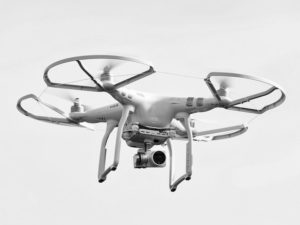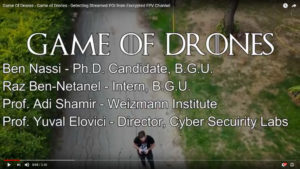
A Radio Trick Can Tell if a Drone Is Watching You
A Radio Trick Can Tell if a Drone Is Watching You
January 12, 2018
Wired – BGU cyber security researchers have built a proof-of-concept system for counter-surveillance against spy drones that can determine whether a certain person or object is under aerial surveillance.
To do this, they first generate a recognizable pattern on whatever subject, such as a window, that someone might want to guard from potential surveillance.
Then they remotely intercept a drone’s radio signals to look for that pattern in the streaming video the drone sends back to its operator. If they spot it, they can determine that the drone is looking at their subject.
In other words, they can see what the drone sees, pulling out their recognizable pattern from the radio signal, without breaking the drone’s encrypted video.
“This is the first method to tell what is being captured in a drone’s [first-person-view] channel” despite that encryption, says Ben Nassi, a Ph.D. student in BGU’s Department of Software and Information Systems Engineering and one of BGU’s researchers who wrote a paper on the technique.
“You can observe without any doubt that someone is watching. If you can control the stimulus and intercept the traffic as well, you can fully understand whether a specific object is being streamed,” says Nassi.
The researchers used a technique known as “delta frames.” Instead of encoding video as a series of raw images, it is compressed into a series of changes from the previous image in the video. That compression feature can reveal key information about the content of the video to someone who’s intercepting the streaming data.
In their tests, the researchers used a “smart film” to toggle the opacity of several panes of a house’s windows, while a DJI Mavic quadcopter drone watched it from the sky, changing the panes from opaque to transparent and back again in an on-off pattern.
Then they showed that with just a parabolic antenna and a laptop, they could intercept the drone’s radio signals to its operator and find that same pattern in the drone’s encrypted data stream to show that the drone must have been looking at the house.
In another test, they put blinking LED lights on a test subject’s shirt, and then were able to pull out the binary code for “SOS” from an encrypted video focused on the person, showing that they could potentially “watermark” a drone’s video feed to prove that it spied on a specific person or building.
All of that may seem like an elaborate setup to catch a spy drone in the act, when it could be just as easy to spot with a decent pair of binoculars. But Nassi argues that the technique works at ranges where it’s difficult to spot a drone in the sky at all, not to mention determine precisely where its camera is pointed.
They tested their method from a range of about 150 feet, but he says with a more expensive antenna, a range of more than a mile is possible. And while radar or other radio techniques can identify a drone’s presence at that range, he says only the BGU researchers’ trick actually knows where it’s looking.
“To really understand what’s being captured, you have to use our method,” Nassi says.





